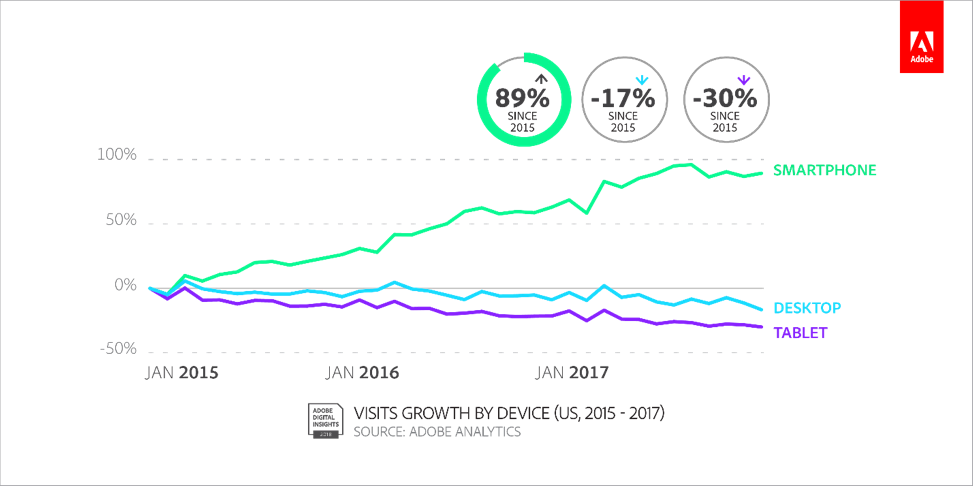The news on the street is that mobile users are spending more money each time they visit an online store, according to a report by Adobe Analytics.
In this article, I’ll talk about what this means for e-commerce and your Facebook funnel in 2018.
Smartphone users are spending more money
2014 was the breakout year when mobile website visits overtook desktop visits, but the amount of sales that resulted from mobile was very small.
Fast-forward to 2018 and mobile visits continue to crush desktop visits. The amount spent by smartphone users has increased by 11% over desktop users, with forecasts predicting this trend to continue at a faster rate.

While the amount of money mobile users spend is rising, the amount of time they spend on a website is going down.
There are dozens of apps fighting for a user’s attention on mobile, making their attention spans shorter. E-commerce brands need to smooth out their mobile funnel to make it as pain-free as possible for users.
If a mobile user needs to trawl through several pages to get what they need, that’s a bad user experience, and studies show they will just leave your website.
The average smartphone is 6 inches in size. When using a mobile connection, time is of the essence. A Google study found that 53% of mobile users leave a website if it takes 3 or more seconds to load.

With the introduction of 5G, the amount of money spent by smartphone users will continue to rise. During the last holiday season, 23% of all sales ($108 billion) were from mobile, with the growth of sales on mobile being much higher than on desktop and tablets.

Where is e-commerce heading?
Unless you need a desktop or laptop for a specific purpose like work, most people rely on their smartphones to handle pretty much everything from meeting friends to paying bills.
Google has already started implementing a mobile-first approach to indexing websites in the search, and not so long ago Facebook started penalizing landing pages that took too long to load (this was because mobile users were having a bad experience waiting for sites to load).
The introduction of Instant Articles, Ad Collections, Canvas, and Lead Generation forms were all to provide mobile users with a faster and smoother experience.
I believe that now is the time to start building Facebook funnels with a mobile-first approach.
Instead of leading visitors to your website, you may want to consider using the mobile ad units above to provide them with a smoother and faster discovery to purchase.
For example, discovery and engagement content could be placed on Facebook where content loads 10x faster than your website, and only the final touch point (the transaction) could be on your site.
Breaking your Facebook funnel into two parts – mobile and desktop – and having different landing pages based on device to provide each user with the best experience possible is another idea.
Having a more stripped out website for mobile users so pages load faster and navigation is easier should see the time spent on your website increase for mobile.
Audit your Facebook strategy for mobile
There are many facets to a Facebook funnel. A single bottleneck can make scaling difficult.
Review your Facebook funnel from a mobile perspective and see where there are issues. Review landing and product pages, and ask yourself how easy it is to get more information on a product, to log in, or to complete checkout on a mobile device.
Mobile users are expecting a simple and fast experience. If your funnel is not up to scratch, you could very well be burning ad spend on mobile clicks with users who click the back button before your site has a chance to load.
Adobe estimated that 5G could bring U.S. retailers up to $12 billion a year in sales by 2021. You must be putting yourself in a position today to take a slice of that pie in the future.
How well is your Facebook strategy and website built for mobile? If you’re not sure where you stand, then get in touch with us today for a free consultation.